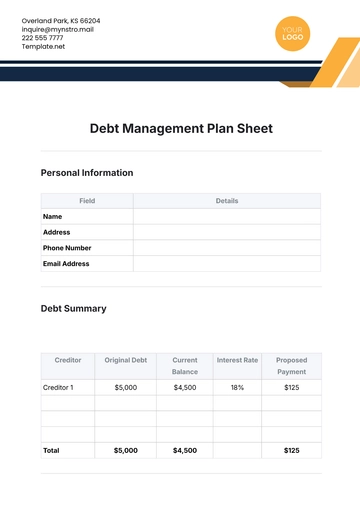Free Finance Debt Repayment Plan

1. Introduction
1.1 Purpose of the Debt Repayment Plan
The purpose of the Debt Repayment Plan is to provide a strategic framework for [Your Company Name] to systematically address and manage its debt obligations. This plan is designed to guide the company through the process of reducing and eventually eliminating outstanding debts in an organized and financially sound manner. By implementing a structured repayment approach, the plan aims to enhance financial stability and operational efficiency. It outlines specific goals, schedules, and methods to ensure that debt repayment is manageable and aligns with the company's overall financial strategy. The ultimate objective is to achieve a debt-free status while maintaining operational integrity and growth.
1.2 Scope of the Plan
The Debt Repayment Plan encompasses all forms of debt held by [Your Company Name], including but not limited to, bank loans, credit card balances, and vendor credits. This plan will address both short-term and long-term debts, detailing each debt's specific terms, repayment schedules, and interest rates. Additionally, the plan covers strategies for managing debt, such as consolidation or refinancing, to optimize repayment efficiency. The scope includes a comprehensive review of the company's financial position, including income and expenses, to ensure that the repayment plan is realistic and achievable. By covering all aspects of debt management, the plan aims to provide a holistic approach to achieving financial stability.
1.3 Key Definitions
Debt: An obligation that requires [Your Company Name] to repay borrowed money, often with additional interest, over a specified period.
Repayment: The process of returning borrowed funds, including both principal and interest, according to a predetermined schedule.
Principal: The initial amount of money borrowed, excluding any interest charges.
Interest: The cost associated with borrowing money, typically expressed as a percentage of the principal amount.
Amortization: The gradual reduction of a debt through scheduled payments over time, covering both principal and interest components.
Understanding these definitions is crucial for comprehending the terms and concepts related to debt management and repayment.
2. Debt Overview
2.1 List of Debts
Creating a detailed list of all outstanding debts is essential for effective debt management. This list should include:
Creditor Name: The entity to which the debt is owed, such as a financial institution, supplier, or individual.
Debt Type: The nature of the debt, which could include term loans, revolving credit, lines of credit, or installment loans.
Outstanding Balance: The current amount of money remaining to be repaid for each debt.
Interest Rate: The rate at which interest is charged on the debt, which affects the total repayment amount.
Repayment Term: The period over which the debt must be repaid, including start and end dates.
For instance:
Creditor Name | Debt Type | Outstanding Balance | Interest Rate | Repayment Term |
|---|---|---|---|---|
Bank A | Loan | $50,000 | 5% | 5 years |
Credit Card B | Credit Card | $10,000 | 18% | 1 year |
Supplier C | Vendor Credit | $7,500 | 8% | 2 years |
This comprehensive listing provides clarity on each debt's specifics, enabling better management and prioritization.
2.2 Current Debt Status
Assessing the current status of each debt involves:
Payment History: Reviewing past payments to determine if any payments were missed or delayed. This analysis helps identify patterns in payment behavior and any associated penalties.
Remaining Term: Calculating the remaining time until the debt is fully repaid, which helps in planning future payments.
Balance Reduction: Tracking changes in the debt balance over time to understand how payments have affected the total debt.
Evaluating the current status allows [Your Company Name] to understand its debt obligations better and make informed decisions about repayment strategies.
2.3 Historical Debt Analysis
Analyzing historical debt data provides valuable insights into:
Debt Accumulation Trends: Examining how debt levels have increased or decreased over time. This analysis helps identify factors contributing to debt growth or reduction.
Payment Trends: Observing how payments have been managed in the past, including any deviations from the planned repayment schedules. This helps in understanding the effectiveness of previous strategies.
Interest Impact: Evaluating how interest rates have affected the total cost of debt over time. This analysis can guide decisions on refinancing or consolidating debts.
Historical analysis is crucial for understanding past practices and improving future debt management strategies.
3. Repayment Strategy
3.1 Repayment Methods
Various repayment methods can be employed to manage debt effectively:
Snowball Method: This approach involves focusing on repaying the smallest debts first while making minimum payments on larger debts. The psychological boost from eliminating small debts can increase motivation and accelerate overall debt repayment.
Avalanche Method: Prioritizing debts with the highest interest rates first reduces the overall interest paid over time. This method is financially efficient as it minimizes the total cost of debt.
Consolidation: Combining multiple debts into a single loan with a lower interest rate simplifies repayment and may reduce the total interest expense. Consolidation can also streamline monthly payments and improve cash flow.
Selecting the appropriate repayment method depends on the company's financial situation and objectives.
3.2 Prioritization of Debts
Effective debt management requires prioritizing debts based on:
Interest Rates: Higher interest rate debts should be prioritized to minimize the total interest expense. Paying off these debts first can lead to significant savings over time.
Debt Amounts: Smaller debts may be repaid first to achieve quick wins and improve cash flow. Eliminating small debts can also simplify financial management.
Repayment Terms: Debts with shorter repayment terms might need more immediate attention to avoid potential penalties or accelerate payments. Managing these debts effectively ensures they are paid off within their terms.
A prioritized list of debts helps in focusing efforts and resources on the most critical obligations.
3.3 Repayment Schedule
The repayment schedule should detail:
Payment Amounts: Specific amounts to be paid towards each debt periodically, including principal and interest components.
Due Dates: Dates by which payments should be made to avoid late fees and penalties. Adhering to due dates ensures that payments are timely and that debts are managed effectively.
Total Repayment Duration: The overall time required to fully repay each debt based on the current payment plan. This duration helps in understanding the long-term financial commitments.
An effective repayment schedule ensures timely payments and keeps the debt repayment process organized and on track.
4. Financial Analysis
4.1 Budget Analysis
Conducting a budget analysis involves:
Income Assessment: Identifying all sources of income, including sales revenue, investment income, and other earnings. Determining the total monthly income available for debt repayment is crucial for budgeting.
Expense Evaluation: Reviewing all regular expenses, such as salaries, utilities, and rent, to understand how much of the income is allocated to these costs. This evaluation helps in identifying the portion of the budget available for debt payments.
Budget Allocation: Allocating a specific portion of the budget for debt repayment, ensuring it aligns with the repayment strategy. This allocation helps in maintaining a balanced budget while managing debt effectively.
A well-structured budget ensures that adequate resources are available for debt repayment and overall financial management.
4.2 Cash Flow Projections
Cash flow projections involve:
Estimating Future Cash Flow: Predicting future income and expenses to determine how much cash will be available for debt payments. Accurate projections help in planning for future financial needs.
Assessing Variability: Identifying potential fluctuations in cash flow, such as seasonal changes or economic factors, and their impact on the repayment plan. Understanding variability helps in preparing for potential challenges.
Adjusting for Changes: Making adjustments to the repayment plan based on projected changes in cash flow. This flexibility ensures that the plan remains realistic and achievable.
Accurate cash flow projections help in managing financial resources effectively and sustaining debt repayments.
4.3 Financial Ratios
Key financial ratios to consider include:
Debt-to-Income Ratio: The ratio of total debt payments to total income, indicating the burden of debt relative to income. A lower ratio suggests a healthier financial position.
Debt Service Coverage Ratio: Measures the company’s ability to meet its debt obligations from operating income. A higher ratio indicates a stronger ability to service debt.
Liquidity Ratio: Assesses the ability to cover short-term obligations with short-term assets. A higher liquidity ratio indicates better short-term financial health.
These ratios provide insights into the company’s financial health and its ability to manage debt effectively.
5. Risk Management
5.1 Identified Risks
Potential risks to consider include:
Interest Rate Fluctuations: Changes in interest rates can impact the cost of variable-rate debts, affecting overall repayment amounts. Monitoring interest rates helps in managing these risks.
Economic Downturns: Economic challenges can reduce income and impact the ability to meet debt payments. Preparing for economic fluctuations helps in mitigating this risk.
Operational Disruptions: Unexpected operational issues, such as equipment failures or supply chain disruptions, can affect cash flow and repayment capabilities. Planning for operational risks helps in maintaining financial stability.
Identifying and understanding these risks allows [Your Company Name] to develop strategies to address potential challenges.
5.2 Mitigation Strategies
To mitigate identified risks:
Hedging: Utilizing financial instruments or strategies to protect against interest rate fluctuations. Hedging can help stabilize debt costs and reduce financial uncertainty.
Diversification: Reducing reliance on a single revenue source by diversifying income streams. This approach helps in maintaining financial stability during economic downturns.
Emergency Fund: Establishing a reserve fund to cover unexpected expenses or disruptions. An emergency fund provides a financial buffer and ensures continuity in debt repayment.
Implementing these strategies helps in managing risks effectively and ensuring a stable financial position.
5.3 Contingency Planning
Contingency planning involves:
Scenario Analysis: Evaluating potential scenarios that could impact debt repayment, such as significant economic changes or major operational issues. Scenario analysis helps in preparing for various outcomes.
Action Plans: Developing action plans for different scenarios, including alternative repayment strategies or cost-cutting measures. Having clear plans ensures readiness to address potential challenges.
Regular Review: Periodically reviewing and updating the contingency plan based on changing conditions and new information. Regular reviews ensure that the plan remains relevant and effective.
Contingency planning ensures that [Your Company Name] is prepared for unexpected events and can adapt its debt management strategy accordingly.
6. Monitoring and Evaluation
6.1 Progress Tracking
Tracking progress involves:
Monitoring Payments: Keeping records of all debt payments made, including dates and amounts. Accurate tracking helps in verifying that payments are being made as planned.
Reviewing Debt Balances: Regularly updating the outstanding balance of each debt to monitor progress. This review provides insight into how effectively debts are being reduced.
Assessing Adherence: Ensuring that the repayment plan is being followed as scheduled and making adjustments if necessary. Adherence to the plan is crucial for achieving debt repayment goals.
Regular progress tracking helps in staying on top of the repayment process and making necessary adjustments.
6.2 Performance Metrics
Key performance metrics include:
Debt Reduction Rate: The rate at which debt balances are decreasing over time. A higher reduction rate indicates effective repayment progress.
Payment Timeliness: Measuring the punctuality of debt payments to ensure that they are made on schedule. Timely payments prevent penalties and maintain a good credit standing.
Budget Adherence: Evaluating how well the company adheres to its budgeted allocation for debt repayment. Adherence to the budget ensures that resources are allocated appropriately.
Performance metrics provide measurable indicators of the effectiveness of the debt repayment plan.
6.3 Plan Review and Adjustments
Regularly reviewing and adjusting the plan involves:
Periodic Reviews: Conducting scheduled reviews of the debt repayment plan to assess its effectiveness and relevance. Periodic reviews help in identifying areas for improvement.
Incorporating Feedback: Considering feedback from stakeholders, financial advisors, or team members to enhance the plan. Feedback can provide valuable insights and suggestions.
Updating Projections: Revising financial projections based on actual performance and changing conditions. Updated projections ensure that the plan remains realistic and achievable.
Ongoing reviews and adjustments ensure that the debt repayment plan remains effective and aligned with [Your Company Name]'s financial goals.
- 100% Customizable, free editor
- Access 1 Million+ Templates, photo’s & graphics
- Download or share as a template
- Click and replace photos, graphics, text, backgrounds
- Resize, crop, AI write & more
- Access advanced editor
Manage your debt with ease using the Finance Debt Repayment Plan Template from Template.net. This customizable template helps you create a clear repayment schedule, track payments, and achieve financial stability. Editable in our AI Editor Tool, it’s designed to fit your specific needs. Download now and take charge of your debt!
You may also like
- Finance Plan
- Construction Plan
- Sales Plan
- Development Plan
- Career Plan
- Budget Plan
- HR Plan
- Education Plan
- Transition Plan
- Work Plan
- Training Plan
- Communication Plan
- Operation Plan
- Health And Safety Plan
- Strategy Plan
- Professional Development Plan
- Advertising Plan
- Risk Management Plan
- Restaurant Plan
- School Plan
- Nursing Home Patient Care Plan
- Nursing Care Plan
- Plan Event
- Startup Plan
- Social Media Plan
- Staffing Plan
- Annual Plan
- Content Plan
- Payment Plan
- Implementation Plan
- Hotel Plan
- Workout Plan
- Accounting Plan
- Campaign Plan
- Essay Plan
- 30 60 90 Day Plan
- Research Plan
- Recruitment Plan
- 90 Day Plan
- Quarterly Plan
- Emergency Plan
- 5 Year Plan
- Gym Plan
- Personal Plan
- IT and Software Plan
- Treatment Plan
- Real Estate Plan
- Law Firm Plan
- Healthcare Plan
- Improvement Plan
- Media Plan
- 5 Year Business Plan
- Learning Plan
- Marketing Campaign Plan
- Travel Agency Plan
- Cleaning Services Plan
- Interior Design Plan
- Performance Plan
- PR Plan
- Birth Plan
- Life Plan
- SEO Plan
- Disaster Recovery Plan
- Continuity Plan
- Launch Plan
- Legal Plan
- Behavior Plan
- Performance Improvement Plan
- Salon Plan
- Security Plan
- Security Management Plan
- Employee Development Plan
- Quality Plan
- Service Improvement Plan
- Growth Plan
- Incident Response Plan
- Basketball Plan
- Emergency Action Plan
- Product Launch Plan
- Spa Plan
- Employee Training Plan
- Data Analysis Plan
- Employee Action Plan
- Territory Plan
- Audit Plan
- Classroom Plan
- Activity Plan
- Parenting Plan
- Care Plan
- Project Execution Plan
- Exercise Plan
- Internship Plan
- Software Development Plan
- Continuous Improvement Plan
- Leave Plan
- 90 Day Sales Plan
- Advertising Agency Plan
- Employee Transition Plan
- Smart Action Plan
- Workplace Safety Plan
- Behavior Change Plan
- Contingency Plan
- Continuity of Operations Plan
- Health Plan
- Quality Control Plan
- Self Plan
- Sports Development Plan
- Change Management Plan
- Ecommerce Plan
- Personal Financial Plan
- Process Improvement Plan
- 30-60-90 Day Sales Plan
- Crisis Management Plan
- Engagement Plan
- Execution Plan
- Pandemic Plan
- Quality Assurance Plan
- Service Continuity Plan
- Agile Project Plan
- Fundraising Plan
- Job Transition Plan
- Asset Maintenance Plan
- Maintenance Plan
- Software Test Plan
- Staff Training and Development Plan
- 3 Year Plan
- Brand Activation Plan
- Release Plan
- Resource Plan
- Risk Mitigation Plan
- Teacher Plan
- 30 60 90 Day Plan for New Manager
- Food Safety Plan
- Food Truck Plan
- Hiring Plan
- Quality Management Plan
- Wellness Plan
- Behavior Intervention Plan
- Bonus Plan
- Investment Plan
- Maternity Leave Plan
- Pandemic Response Plan
- Succession Planning
- Coaching Plan
- Configuration Management Plan
- Remote Work Plan
- Self Care Plan
- Teaching Plan
- 100-Day Plan
- HACCP Plan
- Student Plan
- Sustainability Plan
- 30 60 90 Day Plan for Interview
- Access Plan
- Site Specific Safety Plan





























